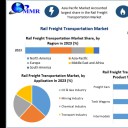
The rail freight market consists of the selling of rail freight transport services by the companies. It transports products from the loading point at the discharge point to again the station that can handle the loading and unloading of cargo.
Global Rail Freight Transportation Market Overview (2024–2030)The Global Rail Freight Transportation Market was valued at USD 7.99 billion in 2023 and is projected to reach USD 9.46 billion by 2030, expanding at a CAGR of 2.45% during the forecast period. Rail freight transportation remains one of the most efficient and sustainable modes of transporting heavy, bulk, and low-value goods such as coal, iron ore, cement, and construction materials. The growing demand for cost-effective, high-capacity, and environmentally friendly logistics solutions continues to drive the expansion of this market across both developed and emerging economies.
Rail freight systems provide an indispensable backbone for industrial and cross-border trade, enabling the seamless movement of goods over long distances while minimizing road congestion and fuel consumption. With increasing focus on sustainability, governments and logistics operators are investing heavily in rail network modernization, digitalization, and intermodal connectivity.
Gain insights into the most attractive segments — click here to receive a free sample of the report: https://www.maximizemarketresearch.com/request-sample/113270/" target="_blank"> https://www.maximizemarketresearch.com/request-sample/113270/
Market Dynamics
Key Growth Drivers
1. Rising Freight Volumes and Infrastructure Development
Expanding industrialization, globalization of trade, and large-scale infrastructure projects have led to a surge in freight volumes globally. Rail freight is increasingly being recognized as a reliable alternative to road and maritime transport, offering lower operational costs and improved efficiency for long-haul shipments. Governments worldwide are investing in upgrading rail networks, expanding double-tracking systems, and electrifying lines to enhance connectivity and reduce transit times.
2. Sustainability and Energy Efficiency
Rail transport is one of the most energy-efficient modes of transportation, consuming significantly less fuel and generating lower emissions than road or air freight. On average, trains are 6–7 times more efficient than trucks and reduce emissions by 30–80%, making them a preferred choice for companies focused on reducing their carbon footprint. The adoption of electric and hybrid locomotives is further supporting the decarbonization of the logistics industry.
3. Growth in Cross-Border Connectivity
The expansion of international rail corridors is fostering cross-border trade, especially between Europe and Asia. The success of the China–Europe Railway Express, connecting over 59 Chinese and 49 European cities, highlights the growing importance of rail freight in global logistics. These corridors are critical to facilitating trade in sectors such as automotive, electronics, consumer goods, and agriculture.
4. Technological Advancements and Digital Transformation
Technological innovations such as IoT-based fleet monitoring, predictive maintenance, automated cargo tracking, and smart terminals are transforming rail operations. These advancements enhance reliability, reduce downtime, and improve supply chain visibility, making rail freight more competitive and appealing to shippers.
Market Challenges
Despite steady growth, several challenges hinder the sector’s full potential:
High Initial Infrastructure Costs: Developing and maintaining railway infrastructure requires significant capital investment and long gestation periods.
Regulatory and Cross-Border Barriers: Differences in technical standards, customs regulations, and ownership structures across countries often lead to operational inefficiencies.
Energy Taxation in Developed Economies: Higher energy taxes in the U.S. and Europe increase operational expenses, reducing cost competitiveness.
Competition from Road and Maritime Transport: The flexibility of trucking and the capacity of maritime transport continue to pose challenges to rail freight growth, especially in short-distance logistics.
Market Segmentation Analysis
By Product Type
Intermodal Segment:
The intermodal segment leads the market and is expected to maintain dominance through 2030. By combining rail with other transport modes like trucks and ships, intermodal systems optimize logistics costs and reduce highway congestion. They can also cut fuel costs by over 40% and carbon emissions by up to 75%, driving rapid adoption among logistics companies.
Tank Wagons:
The tank wagon segment is anticipated to grow at a CAGR of 4.6%, supported by rising demand from the chemical and oil & gas sectors for safe and efficient liquid and gas transport.
Freight Cars:
Freight cars continue to play a vital role in moving bulk commodities, especially in mining, agriculture, and construction.
By Application
Oil & Gas Industry:
Dominates the market due to the high volume of crude oil, refined products, and industrial gases transported via rail.
Mining Industry:
Increasing production of coal, iron ore, and other minerals supports steady growth.
Chemical and Transport Industries:
Both segments are expected to record stable growth as global supply chains diversify and expand their intermodal networks.
Regional Insights
North America
North America holds a major share of the global rail freight market, driven by its extensive network of over 200,000 miles. The U.S. leads the region, accounting for 34.4% of global revenue in 2022, supported by strong demand from agriculture, manufacturing, and energy industries. The region’s focus on digitization and autonomous rail systems is enhancing network efficiency and safety.
Europe
Europe continues to prioritize green logistics, with the EU Green Deal accelerating modal shift from road to rail. Germany, France, and the U.K. are major contributors, with Germany’s market expected to grow at a 3.3% CAGR through 2030. Investments in intermodal hubs and electrified corridors are central to regional growth.
Asia Pacific (APAC)
APAC is the fastest-growing regional market, led by China and India. China plans to increase rail freight capacity by 30%, while India operates the world’s third-largest rail network, with around 9,000 freight trains running daily. Rising trade activity, infrastructure investments, and government-led initiatives like India’s Dedicated Freight Corridor (DFC) are accelerating regional market expansion.
Middle East & Africa (MEA)
Countries in the Gulf Cooperation Council (GCC) are investing in large-scale logistics projects such as the GCC Railway Network, enhancing regional connectivity. Africa’s developing economies are also modernizing rail systems to support mining and agricultural exports.
South America
The region, led by Brazil and Argentina, is experiencing growth in agricultural exports and infrastructure development, prompting greater reliance on rail for bulk transport.
Gain insights into the most attractive segments — click here to receive a free sample of the report: https://www.maximizemarketresearch.com/request-sample/113270/" target="_blank"> https://www.maximizemarketresearch.com/request-sample/113270/
Competitive Landscape
The rail freight transportation market is moderately consolidated, with major players investing in fleet modernization, digital tracking, and green technologies. Strategic collaborations, mergers, and network expansions are common growth strategies.
Key Players Include:
CN Railway
BNSF Railway
Union Pacific
SBB Cargo
CTL Logistics
PKP Cargo
Colas Rail
RSI Logistics
Nippon Express
SNCF
DB Schenker
Deutsche Bahn AG
Canadian National Railway
Union Pacific Railroad
CSX Corporation
Future Outlook
The Global Rail Freight Transportation Market is poised for steady expansion through 2030, supported by increased global trade, sustainability initiatives, and cross-border connectivity. Emerging technologies like AI-based logistics optimization, digital twins, and blockchain-enabled freight management will further improve transparency and efficiency.
As global economies push toward decarbonization and supply chain resilience, rail freight transportation will remain an essential pillar of the logistics ecosystem, combining cost efficiency, scalability, and environmental responsibility to meet the growing demands of modern trade.






 supriyamaximize
supriyamaximize
 poojammr
poojammr alicecgibson
alicecgibson